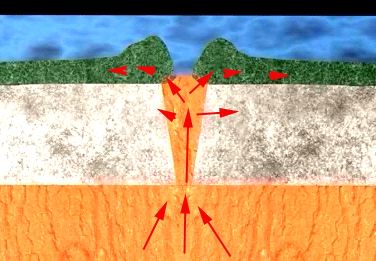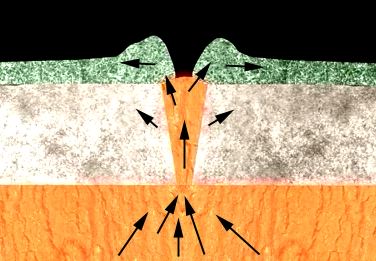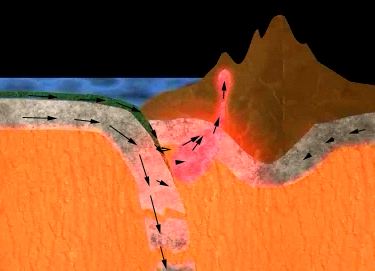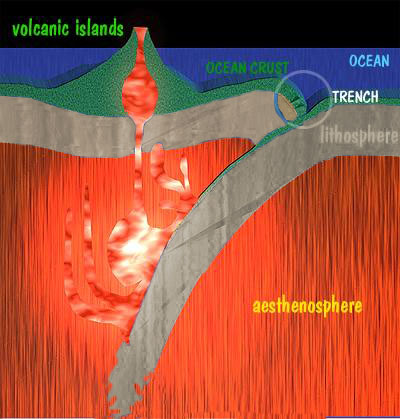
Divergent Plates - two tectonic plates that move away from one another can be found at the mid-ocean ridge. Upswelling magma rises and moves out away from the center. At this point new ocean crust is being formed and moving the resultant ocean basins away from one another.
BLUE = Ocean water
GREEN = Ocean Crust
WHITE/BROWN = Lithosphere
ORANGE = Aesthenosphere

The same type of structure can also be found on land, in Iceland, the mid-Atlantic ridge rises above sea level and the resultant feature is a step sided valley running form south to north through Iceland.
Another such valley is located in south eastern Africa. It is called the Great Rift Valley and again is a point at which the two plates are being formed by the up rising of magma from the aesthenosphere.
The crust and the lithosphere are both being pushed away from the spreading center. The energy and rock come from the asthenosphere and the energy is supplied by heat convection from within the lower mantle.

Convergent Plates - The first type of convergent margin is located at the edge of a continent and the ocean crust. The ocean crust is spreading and when it contacts a continent it is forced down and slides under the continent.
This contact area is known as the "subduction zone", and is a highly reactive environment. The Oceanic crust is pinched between the continental crust and the continental lithosphere. The lithosphere below the oceanic crust also dives below the continent and its lithosphere.
The two crusts and associated lithospheres come together under great pressure and produce tremendous amounts of heat.

The heat may be sufficient to melt the local rocks and create large pools of magma that rise to the surface forming volcanoes. The rock mixtures formed at these "squeeze" points also contain above average concentrations of water and carbon dioxide subducted from the water saturated rock on the ocean floor. These volatiles produce high energy magmas and can produce explosive volcanic eruptions.
When two convergent plates meet in the ocean away from a continent, the resultant formation is an ocean trench. The trenches are the deepest areas in the ocean. Over many million years the contact points are no longer visible because sedimentation has deposited tons of silt in the trenches. They kind of act like large trash receptacles. The silt is subducted at the plate boundary and produces more magma and volcanic island chains.
Subduction zones are marked by a series of volcanoes about 150 km from the actually contact points. They also tend to focal points for seismic activity and many earthquakes are centered along the their juncture.
| NEXT | TOC | PREV |